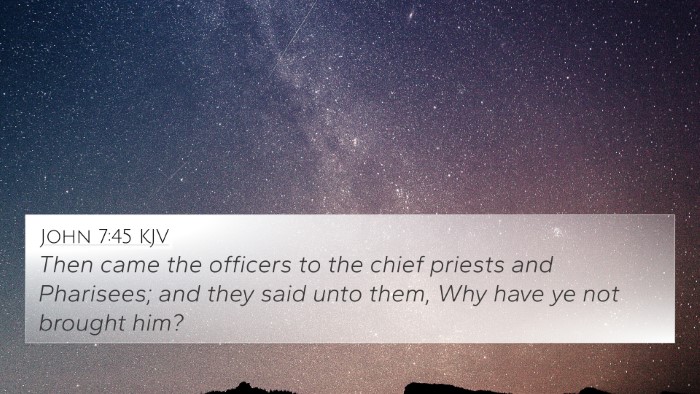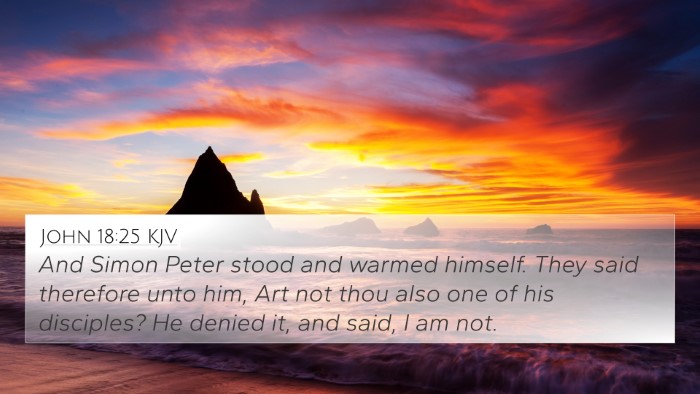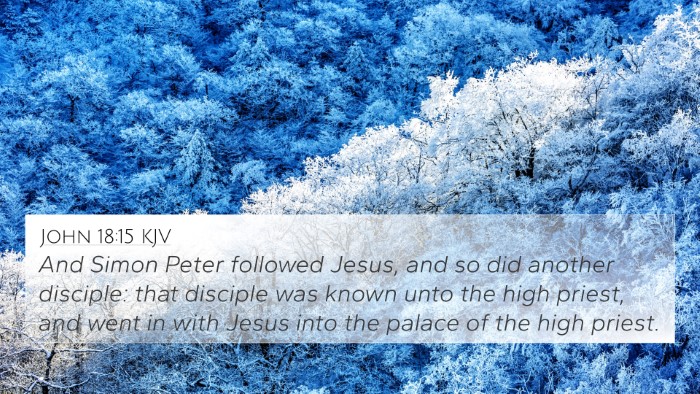Exploring Matthew 26:58: A Study on Peter's Shadow
Bible Verse: Matthew 26:58 - "But Peter followed him at a distance, to the high priest's courtyard. He went in and sat with the guards to see the end."
This verse marks a pivotal moment in the narrative of Jesus' arrest and trial. It highlights the character of Peter, his loyalty, and the complexity of his faith during a time of crisis.
Meaning and Interpretation of Matthew 26:58
The insights from Matthew Henry, Albert Barnes, and Adam Clarke collectively provide a nuanced understanding of this verse:
- Peter's Boldness and Fear: According to Matthew Henry, Peter’s initial boldness in cutting off the servant’s ear demonstrates his desire to defend Jesus, yet his decision to follow at a distance signifies fear and uncertainty.
- The Distance from Jesus: Albert Barnes highlights the implications of following "at a distance," suggesting that Peter’s separation from Jesus foreshadows the eventual denial and the vulnerability of not being close to the Lord during trials.
- Inner Conflict: Adam Clarke notes that Peter’s action of sitting with the guards reflects an internal struggle—wondering where his allegiance truly lay amid danger and potential persecution.
Insights from Commentaries
These interpretations suggest a deeper theme of human frailty and the challenge of faith under pressure:
- Fear vs. Faith: All three commentators agree that Peter's journey represents the struggle between fear and faith, a recurring theme in the Gospels.
- Community and Isolation: The mention of sitting with guards illustrates the tension between community (fellow believers) and the pressure to conform to societal expectations.
- Preparation for Denial: Peter’s following Jesus at a distance is a precursor to his eventual denial, which serves as a sobering reminder of the unpredictability of human resolve.
Cross-References to Matthew 26:58
This verse can be linked to various other scriptures that provide thematic depth and inter-Biblical dialogue:
- John 18:15-18: Where Peter is identified as a follower of Jesus in the high priest’s courtyard.
- Mark 14:54: Another account of Peter following Jesus at a distance and warming himself by the fire.
- Luke 22:54: Describing Peter’s denial and his presence amidst the crowd that apprehended Jesus.
- Matthew 26:69-75: Further detailing Peter's denial of Jesus, showing the contrast between his initial boldness and later fear.
- Luke 22:31-32: Jesus predicts Peter's denial and reassures him of restoration, showing that failure is not final.
- John 21:15-19: Jesus restores Peter after the resurrection, reinforcing the theme of forgiveness and purpose.
- Acts 4:13: Peter’s transformation from fear to boldness after Pentecost highlights the work of the Holy Spirit in empowering believers.
- 1 Peter 5:8-9: Peter later provides counsel on standing firm in faith, possibly reflecting on his experiences through the trial.
- Galatians 2:11-14: Mention of Peter later struggling within the early church context, illustrating his ongoing journey of faith.
- Hebrews 10:24-25: An encouragement to remain steadfast in faith and not forsake gathering with believers, contrasting Peter's initial isolation.
Understanding Links Between Bible Verses
The connections between these verses create a rich tapestry of Peter's journey and emotions:
- Through Bible verse cross-references, one can explore the continuity of Peter's experience from fear to restoration.
- These scriptural connections provide essential insights when examining the thematic links between the Gospels.
- Cross-referencing Biblical texts allows for a deeper understanding of how one event leads to another, revealing God’s grace and Peter’s transformation.
Application of Cross-Referencing in Bible Study
Utilizing tools for Bible cross-referencing, such as concordances and cross-reference guides, enhances understanding:
- When studying this passage, apply cross-reference Bible study methods to identify how Peter's experiences interact with other biblical figures.
- Use Bible reference resources to find supporting verses that resonate with themes of courage, fear, and redemption.
- Engage in comparative Bible verse analysis to deepen insights into loyalty and betrayal as illustrated across various scriptures.
Final Thoughts
The journey through Matthew 26:58 offers profound lessons about faith, fear, and the grace of restoration. By connecting this verse with others, one can appreciate the depth of Peter's struggles and triumphs, providing a model for modern-day believers in the face of their challenges.
Keywords: Cross-referencing Biblical texts, connections between Bible verses, comparative Bible verse analysis, Bible verses that relate to each other.






